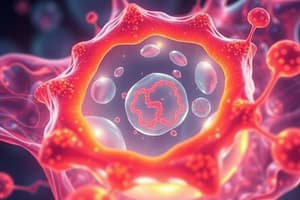Podcast
Questions and Answers
What is the primary function of mitochondria?
What is the primary function of mitochondria?
- Production of cellular membranes
- Site of aerobic respiration for ATP synthesis (correct)
- Site of photosynthesis
- Storage of genetic material
What unique feature do mitochondria possess that allows them to be semi-autonomous?
What unique feature do mitochondria possess that allows them to be semi-autonomous?
- Presence of a double membrane
- Containment of circular mitochondrial DNA (correct)
- Ability to perform photosynthesis
- Storage of fatty acids
Which part of the mitochondrion is responsible for generating a proton gradient?
Which part of the mitochondrion is responsible for generating a proton gradient?
- Intermembrane space (correct)
- Mitochondrial matrix
- Cristae
- Outer membrane
What is the shape of chloroplasts?
What is the shape of chloroplasts?
What process allows chloroplasts to move through the cell?
What process allows chloroplasts to move through the cell?
Which component of the mitochondrion is specifically involved in ATP synthesis?
Which component of the mitochondrion is specifically involved in ATP synthesis?
What is held in the mitochondrial matrix?
What is held in the mitochondrial matrix?
What is the maximum length range for the mitochondrion?
What is the maximum length range for the mitochondrion?
Which statement accurately describes a principle of the cell theory?
Which statement accurately describes a principle of the cell theory?
Why are most cells small?
Why are most cells small?
Which organelle is continuous with the nuclear envelope?
Which organelle is continuous with the nuclear envelope?
In eukaryotic cells, where are secretory proteins synthesized?
In eukaryotic cells, where are secretory proteins synthesized?
Which statement about ribosomes is correct?
Which statement about ribosomes is correct?
What does the term 'obligate intracellular parasites' refer to?
What does the term 'obligate intracellular parasites' refer to?
Which of the following statements about viruses is false?
Which of the following statements about viruses is false?
What is the primary function of ribosomes?
What is the primary function of ribosomes?
Where are proteins destined for secretion synthesized?
Where are proteins destined for secretion synthesized?
Which of the following correctly describes the structure of centrioles?
Which of the following correctly describes the structure of centrioles?
What is one of the primary functions of the cytosol?
What is one of the primary functions of the cytosol?
Which protein components are transported into the nucleolus for ribosomal assembly?
Which protein components are transported into the nucleolus for ribosomal assembly?
Which statement accurately reflects the cytoskeleton's composition?
Which statement accurately reflects the cytoskeleton's composition?
What critical role do centrioles serve during cell division?
What critical role do centrioles serve during cell division?
Which of the following is a function of the cytoskeleton?
Which of the following is a function of the cytoskeleton?
What is the percentage of water typically found in the cytoplasmic matrix?
What is the percentage of water typically found in the cytoplasmic matrix?
What is the primary stain used in the Gram staining process?
What is the primary stain used in the Gram staining process?
How does the structure of Gram-positive bacteria differ from Gram-negative bacteria in terms of peptidoglycan?
How does the structure of Gram-positive bacteria differ from Gram-negative bacteria in terms of peptidoglycan?
What role does the outer membrane play in Gram-negative bacteria?
What role does the outer membrane play in Gram-negative bacteria?
Which of the following statements about mesosomes is correct?
Which of the following statements about mesosomes is correct?
Where is bacterial genetic material found?
Where is bacterial genetic material found?
What is the composition of bacterial ribosomes?
What is the composition of bacterial ribosomes?
Which type of bacteria contains photosynthetic membranes?
Which type of bacteria contains photosynthetic membranes?
What is the role of the peptidoglycan layer in bacterial cells?
What is the role of the peptidoglycan layer in bacterial cells?
What is the primary role of the capsid in a virus?
What is the primary role of the capsid in a virus?
What are the structural units that make up the capsid known as?
What are the structural units that make up the capsid known as?
How do enveloped viruses acquire their membrane?
How do enveloped viruses acquire their membrane?
What role do glycoprotein spikes serve in enveloped viruses?
What role do glycoprotein spikes serve in enveloped viruses?
What distinguishes naked viruses from enveloped viruses?
What distinguishes naked viruses from enveloped viruses?
What type of viruses are bacteriophages?
What type of viruses are bacteriophages?
Which statement is true regarding the assembly of capsids?
Which statement is true regarding the assembly of capsids?
What components primarily make up the viral envelope?
What components primarily make up the viral envelope?
Flashcards are hidden until you start studying
Study Notes
Cell Theory
- Modern Cell Theory developed by Schleiden and Schwann in 1938.
- Cells are the smallest unit of life and perform all necessary life processes (e.g., ATP and protein synthesis).
- Living cells arise from pre-existing living cells through processes like mitosis, meiosis, cytokinesis, and binary fission in prokaryotes.
- All living organisms consist of one or more cells, where all life-sustaining chemical reactions occur.
Mitochondria
- Mitochondria are rod-shaped or cylindrical with sizes ranging from 0.5-1.5 μm in diameter and 2.5-10 μm in length.
- Enclosed by a double membrane: smooth outer membrane is permeable to small solutes, while the inner membrane forms cristae to increase surface area for enzyme attachment.
- The intermembrane space is crucial for generating a proton gradient for the electron transport chain.
- The mitochondrial matrix contains circular mitochondrial DNA (mtDNA) and 70S ribosomes, allowing mitochondria to grow and divide independently.
- Mitochondria are the site of aerobic respiration and ATP synthesis.
Chloroplasts
- Chloroplasts are biconvex, lens-shaped organelles that move within cells via cytoplasmic streaming to optimize light absorption.
- Enclosed by a double membrane known as the chloroplast envelope, with a narrow intermembrane space.
Ribosome Synthesis in Eukaryotes
- Ribosomal RNA (rRNA) is transcribed in the nucleolus, and ribosomal proteins are produced in the nucleus.
- Proteins and rRNA combine in the nucleolus to form ribosomal subunits, which are assembled on mRNA during translation.
Centrioles
- Centrioles are found in animal cells and lower plant cells but absent in higher plant cells.
- Exist as pairs of perpendicular rod-like structures composed of microtubule triplets arranged in a ring.
- Organize spindle fibers during cell division.
Cytosol
- The cytosolic matrix is composed of 90% water, organic molecules, inorganic ions, and waste products.
- Functions include storage of vital chemicals and serving as the site for various metabolic pathways like glycolysis and translation.
Cytoskeleton
- A dynamic network of fibres providing structural support and facilitating cell movement.
- Comprises microtubules, intermediate fibers, and microfilaments, maintaining cell shape and anchoring organelles.
Plasma Membrane
- The plasma membrane is partially permeable, similar to eukaryotic membranes, and plays a role in cellular function.
- Mesosomes are infoldings found in some bacteria, aiding in the separation of DNA during binary fission and increasing surface area for enzymatic reactions.
Genetic Material in Bacteria
- Bacteria have a single circular double-stranded DNA chromosome located in the nucleoid region, associated with histone-like proteins.
- Transcriptionally active genes are found in loosely coiled regions, while inactive genes are in supercoiled regions.
Ribosomes
- Bacterial ribosomes are 70S, distinct from eukaryotic ribosomes, and crucial for protein synthesis.
Viral Structure
- The capsid is a protective protein coat surrounding the viral genome, composed of capsomeres.
- Some viruses are naked, containing only a genome and capsid.
- Enveloped viruses possess a membranous envelope derived from host cell membranes, incorporating viral and host proteins for cell recognition and attachment.
- Bacteriophages specifically infect bacteria.
Studying That Suits You
Use AI to generate personalized quizzes and flashcards to suit your learning preferences.




